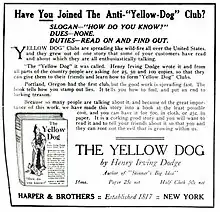
The Anti-Yellow Dog Clubs (also referred to as The Yellow Dog Clubbers Club)[1] were American anti-seditionist clubs during World War I inspired by Henry Irving Dodge's story "The Yellow Dog",[2] which first appeared in The Saturday Evening Post on March 4, 1918. Members of these clubs (largely schoolboys) wielded the story's definition ("If a man talks against the government and can't back up what he says, he's a 'yellow dog'.")[3] on their quest to confront "yellow dogs". There were thousands of these clubs across the US, and they were the target of both support[4] and scorn.[5] Total membership was in the millions.[6] The clubs were endorsed by political figures including Theodore Roosevelt. [7] They were promoted in concert with both the book edition of the story and its movie adaptation. Movie theater owners started promoting the clubs before production on the film had even started, as an advance publicity campaign.[8]

References
- ↑ "Join the Yellow Dog Clubbers Club". Employes Magazine. Buffalo, Rochester, and Pittsburgh Railway Company. August 1918.
- ↑ "Bisbee Boys Band Together to Hunt for Illusive Yellow Dogs". Bisbee Daily Review. September 22, 1918.
- ↑ ""Yellow Dog" Hunters". The Buffalo Enquirer. May 3, 1918.
- ↑ ""Yellow Dog" Plan is Endorsed by Neville". Omaha World-Herald. July 26, 1918.
- ↑ "The Yellow Dog Clubs". The Nonpartisan Leader. November 18, 1918. p. 7.
- ↑ Between Free Speech and Propaganda: :Denaturing the Political in the Early American Movie Industry, dissertation By John D. Steinmetz, June 2016, p. 162
- ↑ "Theodore Roosevelt Praises Work of the Anti-Yellow Dog Club" (PDF). Harrisburg Telegraph. August 16, 1918. p. 14.
- ↑ Steinmetz, p. 161
External links
- "Holding the Ladder", a newspaper story by Henry irving Dodge in support of using boys for anti-yellow dog activities